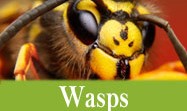
Wasps in Spain, generally, start to become a nuisance around the end of April depending on the weather, and this is possibly the best time to think about a treatment to combat the nests,before the summer comes and their presence stops you from enjoying outdoor living such as barbecues and al fresco dining. The nests are normally found underneath the Spanish roof tiles with the wasps entering and exiting from the front and sides of each tile. We can do a treatment where we target each nest by directing a jet of insecticide under the tile which kills the wasps whilst still inside the nest. In some cases , the small walnut size nests can be found under the eaves of the house. These we can treat and remove.
In the early spring, a young queen will come out of her dormant winter state and build a small nest about the size of a walnut or as explained earlier, under a convenient roof tile where it is protected from the elements.Wasps prefer dry concealed locations,and it is incredible the temperatures that they can withstand as the hot Spanish sun beats down on roof tiles and hollow fence posts made of metal.
To begin with, the nest will contain 10 to 20 hexagonal cells and the queen will lay an egg into each one. As these hatch, the queen will busily feed the emerging larvae. Towards the end of May, these will have pupated and turned into workers who will start growing the nest and feeding the emerging larvae, leaving the queen to concentrate on laying eggs. Larvae produce a sweet substance over their skin that acts as a reward for worker wasps that bring food back to them. By early September the nest will have grown and depending on the space available to expand, the nest could contain up to a couple of hundred wasps.
Wasps feed their young on insect larvae and flies – which they will kill with their sting – and carrion such as dead rodents. And, of course, the spare ribs and drumsticks that will be by the barbecue during the summer. They also have a liking for sweet things and they can damage growing soft fruits and young apples on trees.
As summer nears its end, special large cells containing the next generation of queens and breeding males will be made. Once these have reached adulthood, the workers have no more larvae to feed and become redundant. The workers still crave the larvae’s sweet reward, which is when wasps become a nuisance by crawling into coke cans and hanging around café bins and enjoying food we leave on outdoor tables, in search of this. This is also when the wasps are at their most aggressive and most likely to use their nasty sting, often attacking anything moving too near to the nest. If you are being harassed by wasps the worst thing you can do is to start flailing your arms about and panicking. I know it is hard but, it is best to stay still and composed so that the wasp does not feel threatened and becomes even more angry.
Wasp nest removal on the Costa Del Sol.
It is easiest to treat a wasps’ nest at the beginning of the season, when the nest is tiny. A quick treatment with fly spray will destroy the nest. As the nest grows – the treatment becomes more complicated – the wasps will have a direct flight path to and from the nest and, if you stand in the wrong place, they may well attack you. If you are going to attempt to spray yourself, then do it at night when the wasps are in the nest. DONT get too close !!
If a wasp nest is established or in a difficult to reach place it is far safer to call in a professional pest controller who has the safety equipment and the correct products to safely control the nest.
FACTS ABOUT WASPS
- A wasp can sting repeatedly and the sting can penetrate thick gloves.
- Wasps feeding on fermenting juice have been known to get “drunk’ and pass out.
- Wasps live in colonies that form self-contained communities, each following a caste order of queens, males and workers.
- The wasp is a social insect of the same order as ants, Hymenoptera (a name which refers to the types of wing that these insects have).
- There are over 7,000 types of wasp that inhabit our part of the world including many variants of parasitic wasps.
- When wasps attack they release a pheromone that will tell all of the other wasps in the nest and nearby that their nest is under attack and out they will come and attack the attacker.
- A male wasp is called a drone. The job of the drone is to mate with the Queen. Shortly after, the drone will go off and die..
- In the spring they are generally regarded as beneficial insects by gardeners, removing greenfly and blackfly.
- If you look carefully on soft wood, such as park benches and fence posts, you can often spot scrape marks that are made when worker wasps collect material to build-up their delicate nests.
- Wasps dont swarm
- Wasp stings do not have barbs, which means that a wasp can sting us repeatedly.
